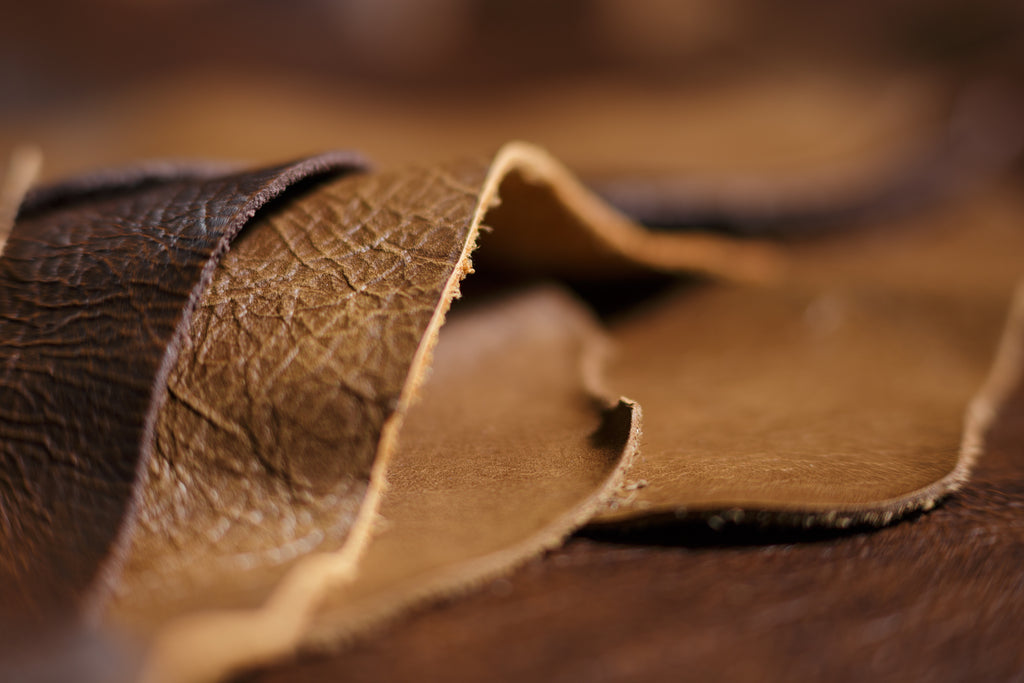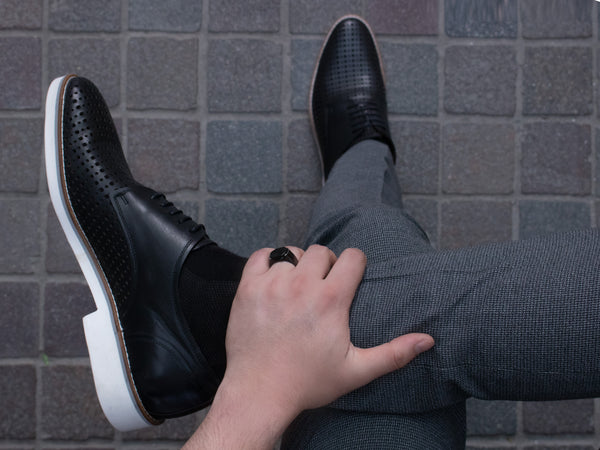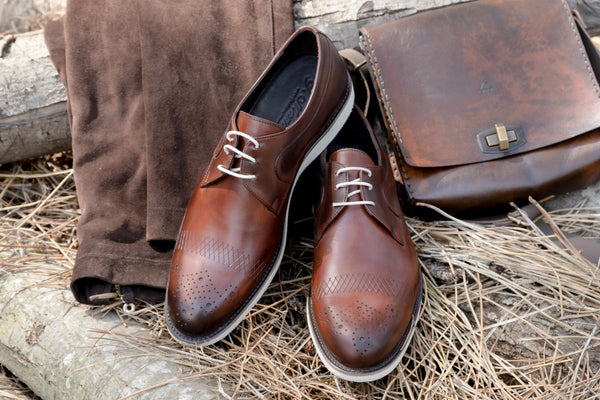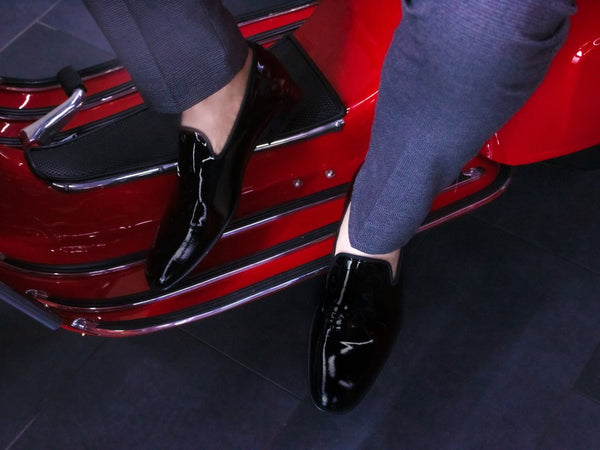Full Grain, Top Grain, and Genuine Leather : The Hierarchy
Written By SHILOH BECKETT •

In this article, we aim to shed light on the three most commonly mentioned types of “real leather” in the men's leather dress shoes sector: Full Grain, Top Grain, and Genuine Leather. At first glance, the naming may mislead many, hinting at a hierarchy that isn't precisely accurate. Here, for our Debbano followers, we'll unravel the maze of these popular leather varieties and debunk some persistent myths that can sometimes be not just misleading but even exploitative in nature.
Genuine, Top Grain, and Full Grain Leather: The First Thought Configuration
For a novice, deciphering the actual quality order of these leather types can be baffling. Many would assume that "Top Grain" signifies the topmost quality because, well, it has "top" in the name. Similarly, with "Genuine Leather", one might wonder: Aren’t we all looking for genuine friends who show genuine concern? Yet, when it comes to men's leather dress shoes, these assumptions can be misleading.
Full Grain, Top Grain & Genuine Leather: Time to Rearrange the Hierarchy
Before diving deep, it's essential to recognize that these three aren't the only types of leather utilized in the men's dress shoe industry. Other kinds, like suede, nubuck, aniline, exotic leathers, and patent leather, also play significant roles. For an in-depth read on those, you might want to refer to our expert Eligio Farina's comprehensive blog.
Back to our main topic: in terms of leather quality, the order should be Full Grain, Top Grain, and then Genuine Leather, contrary to some popular beliefs. Let's dissect each one:

Fundamentals
Leather is essentially composed of fibers intertwined relatively tightly with each other. The comparatively hard, callous-like part of this organic structure that is exposed to the outside world and its effects is called the "grain." The grain acts like a protective barrier, ensuring the strength, durability, and integrity of the inner parts of the leather. It safeguards and supports the fibers and tissues behind it. Without the grain, the leather texture is weak and defenseless.
Full Grain Leather
It is the chief among the trio of Full Grain, Top Grain, and Genuine Leather, standing at the pinnacle of the quality hierarchy. One should really call it Genuine Top-Tier Leather😅. It corresponds to the uppermost part of the hide and denotes the surface closest to the hair. It directly bears the marks of the external world and the wear and tear of life. Scars, scratches, cuts, color, and texture variations that appear when the hair part is shaved off are preserved exactly as they are. It is not subjected to any grinding or sanding. Each piece provides a unique expression, an embodied history, and finally, a wonderful set of natural characteristics that an unknowing eye might mistake for imperfections.
- Ages beautifully over time. Develops a visually pleasing, rich patina.
- Highly durable and long-lasting. Its resilience, elasticity, and thickness are superior.
- Due to its resilience and thickness, bending, stitching, and shaping can be challenging. As a result, in the context of men's dress shoes, craftsmanship costs are higher.
- It has a breathable structure. The probability of retaining moisture is relatively lower.
- The initial stiffness and longer break-in period you might see in quality shoe reviews is due to the rugged texture of full grain leather.
- Since its surface is untreated, it can be more susceptible and vulnerable to scratches.
- Even though it might come at a higher price point, we can say that full grain leather men’s dress shoes are a lifetime investment.

Top Grain Leather
Next up is top grain leather. Due to a longstanding oddity, which we hinted at in the introduction, this type of leather has been named "top grain." However, as mentioned, the true top part actually refers to full grain leather. Or at least, it should. If you are looking for an upper that is more uniform in appearance, softer, more consistent, and easily dyeable, then chances are you are leaning towards top grain leather. Top grain leather is produced by splitting or sanding the outermost part of the hide. This process removes surface imperfections.It's a suitable option for those who prefer consistent coloring. Although the removal of surface "flaws" and hairs may present a "tabula rasa" or a blank canvas for shoe artisans, there are also certain drawbacks that we will outline shortly.
- Although it appears in the middle of our blog's didactic scale, which categorizes leather into full grain, top grain, and genuine leather, it's actually a premium leather variation closely aligned with full grain in quality.
- Due to its ease of processing, it's suitable for embossing and similar leather surface applications and treatments.
- Its polished surface is more resistant to dirt and stains, requiring less maintenance.
- However, due to its limited ability to absorb ambient and additive oils, it's less resilient to drying and cracking compared to full grain leather. Because it's processed, its natural fiber structure has undergone changes, making it slightly less durable.
- Nevertheless, for a vast majority seeking a balance between quality and aesthetics without wanting to spend exorbitant amounts, it remains a reliable choice.
Genuine Leather
As mentioned in the introduction, its name can be misleading. We shouldn't be deceived by the sense of reassurance its nomenclature might imply in people. Nevertheless, it's a reality that countless sellers have leveraged this to promote their low-quality leather products as if they were "real leather," misleading their customers. By now, you've probably realized that it sits at the very bottom of the hierarchy, starting with full grain, top grain ranking. Genuine leather, which is crafted from the innermost layers of the hide and lower-quality remnants, lacks the grain layer we previously discussed. It's typically coated with a plastic layer, and this layer is often embossed to imitate the appearance of grain.
- In terms of durability, it comes well after full grain and top grain leathers.
- Due to its processed nature, it's suitable for different texture patterns and finishes.
- It can be preferred for "trendy" products that aren't meant to last more than a season or two.
- Being much more affordable than full grain and top grain leathers, it can be a viable option for those on a tighter budget.
In Conclusion...
We believe things have become clearer now. In the world of leather goods and accessories, especially men's dress shoes, these three leather types - full grain, top grain, and genuine leather - possess a hierarchy that might differ from the connotations their names suggest. Genuine leather might not be that "real" after all. Top grain leather isn't the top-quality leather one might presume from its name. However, it is a good quality leather when considering a balance between aesthetics and functionality. At the pinnacle of the hierarchy, with its raw beauty, longevity, and uniquely textured identity, sits full grain leather. We've mentioned multiple times how understanding these basics can lead to more informed purchasing decisions. Lastly, for those curious about Debbano's men's dress shoes, let me clarify. We extensively use both full grain, top grain leathers in our shoes, which boast European quality standards. As for genuine leather, it simply doesn't align with our preference or concept.
Follow Us
Inspired by its native soil in Europe, where not only the continents but also many magnificent civilizations meet, Debbano gathers peerless sophistication, beauty, artistry, and, ultimately, the gloriousness of the best quality leather with its unique patterns and identity.
Follow us to be updated about style, colors, materials and construction techniques, fashion, lifestyle, and much more, covering the context full grain top grain and genuine leather in shoe industry. You can visit our website and/or follow our Instagram and YouTube channels.





